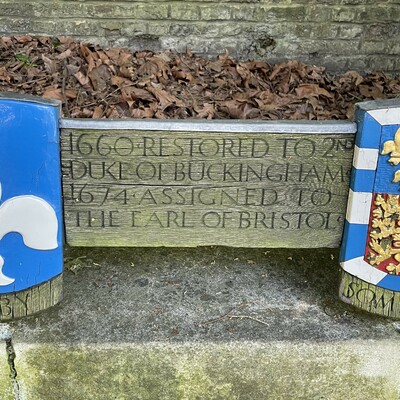Grand mansion built by Thomas More c.1520 and demolished 1739. The house and gardens occupied the land bounded by (clockwise): The Thames, Milman's Street, King's Road, Old Church Street. It was initially known as More's house or Chelsea Park and only acquired the name Beaufort House in 1682 but we use that for simplicity.
During its 200 years the house changed hands repeatedly and was often home to major players in the history of London, and of the whole nation. It was modified and extended repeatedly, and two significant houses were built in the grounds: Lindsey House and Gorges House (later known as Milman House).
Beaufort House can be seen, left of centre in this splendid, coloured, c.1708 3D plan. Lindsey House is at the lower left. Gorges House is between Beaufort House and Lindsey House. We are not convinced that all the features coloured blue on this plan are actually water.
The British History Online source has architectural plans of the House c.1597. There also is a plan of the estate (drawn we think from the 3D plan shown here). This makes it clear that the west elevation of the house formed the east border of the still existing burial ground.
On More's arrest in 1534 the estate was confiscated and granted to Sir William Paulet, the first Marquess of Winchester (one of the judges in More’s trial). In 1572 it was inherited by his son John, the second Marquess (1510 - 1576). On the death in 1586 of John Paulet's widow, his third wife, Winifred, the estate passed to her daughter by a previous husband, Anne Sackville and her husband Gregory Fiennes, 10th Baron Dacre of the South.
Anne and Gregory lived at the House but they had no surviving issue. They both died at the House with Anne surviving Gregory by a few months, dying in 1595 and bequeathing her properties to the 75-year old Lord Burghley (why is not clear since he does not appear to have been a relation). The estate was inherited in 1597 by his youngest son, Robert Cecil, 1st Earl Salisbury.
Cecil immediately remodelled the front of the House, using the designs of architect John Thorpe, and in 1599 sold the estate to Henry Clinton, 2nd Earl of Lincoln who lived in the House. In April 1601 he 'stood up' Queen Elizabeth I who came on a pre-arranged visit. Lincoln's daughter Elizabeth had married Sir Arthur Gorges in 1597 and Lincoln had Gorges House built for them in the grounds.
On Lincoln's death in 1616 Elizabeth and Arthur inherited the estate and in 1619 sold it to Lionel Cranfield. He employing Inigo Jones and Nicholas Stone to improve the House. But he fell out of favour with the King and his property was confiscated and granted in 1627 to George Villiers, first Duke of Buckingham (despite Cranfield having been forgiven in 1625). At this time it was known as Buckingham House. When he was murdered in 1628 the estate passed to his infant son, the second duke, who was brought up a Royalist and fought on behalf of the King in the Civil War. The estate was seized by Parliament and during the Commonwealth was occupied by the Parliamentary Commissioners, Sir Bulstrode Whitlocke and John Lisle.
At the Restoration in 1660 the House was restored to Buckingham but his popularity in Parliament and with the King remained insecure and 1674 was at a low point. In that year George Digby, Earl of Bristol acquired the House. His widow, Anne, sold it to Henry Somerset, Marquess of Worcester. This was in 1682, the same year that he was given the title (1st) Duke of Beaufort. The House became known as Beaufort House. In February 1696 he was suspected of complicity in an assassination plot, the House was searched, but nothing was found to incriminate him.
The House remained in the Beaufort family until 1720. At that date the 3rd Duke, Henry Scudamore, was aged only 13, his father having died when he was only 7. There's then a period of 17 years during which we cannot trace the ownership of the House. But it was described as a ruin by 1737 when Sir Hans Sloane bought it and demolished it in 1740, retrieving the lead from the roof and selling the land on, in parcels, we imagine.
A stone gateway to the estate on the Kings Road, designed by Inigo Jones in 1621, was bought by Lord Burlington (1694 - 1753) removed and rebuilt in his gardens at Chiswick House in 1738. Wikipedia have a photo of it but we don't know where it is in Chiswick House gardens. This prompted Pope to write:
Oh gate, how com'st thou here ?
I was brought from Chelsea last year,
Battered with wind and weather;
Iaigo Jones put me together,
Sir Hans Sloane
Let me alone,
Burlington brought me hither.
Sources: British History Online, Wikipedia, Moravian Close, London Details.






Comments are provided by Facebook, please ensure you are signed in here to see them